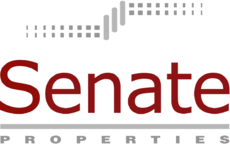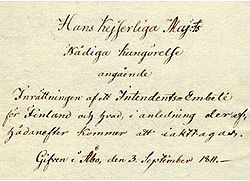- Senate Properties
-
Senate Properties
Finnish: Senaatti-kiinteistöt
Swedish: Senatfastigheter
Type Liikelaitos[1] (≈ unincorporated state-owned enterprise)[2][3] Industry Real estate[3] Predecessor State Real Property Agency (1995 to 1999)[4]
National Board of Public Building (until 1995)[4]Founded Helsinki, Finland (1999)[4] Founder(s) Government of Finland Headquarters Helsinki, Finland[5] Area served Republic of Finland[3] Key people Aulis Kohvakka (Managing Director)[6] Revenue 677 million EUR (2008)  5% from 2007[7]
5% from 2007[7]Operating income 220 million EUR (2008)  6% from 2007[7]
6% from 2007[7]Profit 105 million EUR (2008)  14% from 2007[7]
14% from 2007[7]Total assets 5 857 million EUR (2008)  3% from 2007[8]
3% from 2007[8]Total equity 3 404 million EUR (2008)  steady from 2007[8]
steady from 2007[8]Owner(s) Republic of Finland (100%)[3] Employees 277 (2008)[7] Website Senaatti.com Senate Properties (in Finnish: Senaatti-kiinteistöt, in Swedish: Senatfastigheter) is a Finnish unincorporated state-owned enterprise, which manages a major part of the real estate assets owned by the Republic of Finland.[2][3]
 Declaration made 3 September 1811 by Tsar Alexander I of Russia to establish the Office of the Intendant. Handwriting in Swedish.[9]
Declaration made 3 September 1811 by Tsar Alexander I of Russia to establish the Office of the Intendant. Handwriting in Swedish.[9]
Contents
History
Senate Properties descends from the Office of the Intendant (corresponding names in Finnish and Swedish are listed in the table below), established 3 September 1811, the goal of which was to supervise the planning of government buildings.[9] In 1865, the name was changed to the Board of Public Buildings; and in 1936 to the National Board of Public Building.[9] In 1995, the National Board of Public Building — which was a government agency managing state property — was dissolved. Facility management operations were incorporated into Engel kiinteistöpalveluyhtymä Oy,[10] which was fully privatized in 2004, the buyer being ISS A/S.[11] The majority of the state property assets were transferred into the newly formed State Real Property Agency.[9][10] The purpose of this agency was to manage the state property which was deemed to be in permanent use.[10]
On 1 January 1999, a heterogeneous collection of government real estate worth 1.3 billion EUR was transferred from various government-owned companies and government agencies — including the State Real Property Agency — and incorporated into Kapiteeli Oy.[12] The transfer consisted of buildings deemed redundant from the government perspective.[12] This included former school buildings, empty government buildings, railway stations fallen into disuse, and other buildings that were considered unnecessary for the government to own, such as post offices and hotels.[12] Part of this property was developed and sold on the market between 1999 and 2006.[12] Kapiteeli was privatized in September 2006.[13] The single buyer, Sponda Oyj, paid 950 million EUR for 100% of Kapiteeli's stock.[13]
Also on 1 January 1999, the State Real Property Agency was transformed from being a government agency into being an unincorporated state-owned enterprise.[9][14] During the same year, several culturally significant properties were transferred to the State Real Property Agency, including the Ateneum, Kiasma, and the Finnish National Opera Building.[9]
On March 1, 2001, the name of the State Real Property Agency was changed to Senate Properties.[15] The name-change required a change in law because the State Real Property Agency was a state enterprise under Finnish public law, and such entities could not change their name via registration as in the private sector.[15] The purpose with the name-change was to improve the corporate image[15] by having a name reflecting both traditions and modern business philosophy.[4] The new name also refers to the Helsinki Senate Square, where several nearby buildings are managed by Senate Properties.[4]
Organizational lineage of Senate Properties[9] Year English Finnish Swedish 1811–1865 Office of the Intendant Intendentinkonttori Intendentkontoret 1865–1936 Board of Public Building Yleisten rakennusten ylihallitus Överstyrelsen för allmänna byggnader 1936–1995 National Board of Public Buildings Rakennushallitus Byggnadsstyrelsen 1995–2001 State Real Property Agency Valtion kiinteistölaitos Statens fastighetsverk(note) 2001→ Senate Properties Senaatti-kiinteistöt Senatfastigheter Note: There is also a government agency in Sweden called Statens Fastighetsverk, which handles functions similar to its Finnish counterpart. Legal status
Senate Properties is an unincorporated, fully state-owned enterprise (Finnish: Liikelaitos).[2][3] It is unincorporated in the sense that Senate Properties is not a legal person separate from the State, and compared to incorporated companies, the organization has limited jurisdiction over its activities.[16] Finnish government organizations of this type are governed by the Unincorporated State Enterprise Act of 2002 (Laki Valtion Liikelaitoksista (in Finnish)).[17]
Finance
At the end of 2008, the Finnish government held assets totaling 51.5 billion EUR.[18] Of these assets, 3.8 billion were held in Senate Properties; consisting of 2.6 billion EUR as equity capital, and 1.2 billion as long-term loans.[8] In addition to the equity capital and loans by the Finnish government, Senate Properties had 0.8 billion in retained earnings, and external financing amounting to 1.2 billion from financial institutions.[8] Its balance sheet totaled 5.9 billion at the end of 2008.[8]
Development projects
General information
In 2007, Senate Properties was — out of 29 large Finnish companies — recognized as Finland's top reporter of issues related to the environment and to corporate social responsibility.[21]
Gallery of buildings
-
The Government Palace near the Senate Square.
-
Kesäranta, the official residence of the Prime Minister of Finland, in Meilahti.
-
The contemporary art museum Kiasma on Mannerheimintie.
-
The Supreme Court of Finland on Pohjoisesplanadi.
-
The House of the Estates.
-
The building of the Court of Appeal in Turku.
-
The building of the Court of Appeal in Vaasa.
Notes
- ^ Senate Properties 2009: [1] (Finnish).
- ^ a b c Ministry of Finance 2009.
- ^ a b c d e f Senate Properties 2009: [2]
- ^ a b c d e Senate Properties 2009: [3]
- ^ Senate Properties 2009: [4]
- ^ Senate Properties 2009: [5]
- ^ a b c d Senate Properties Annual Report 2008, p. 20.
- ^ a b c d e Senate Properties Annual Report 2008, p. 22.
- ^ a b c d e f g Senate Properties 2009: [6], [7] (Finnish), [8] (Swedish).
- ^ a b c National Audit Office of Finland 2005, p. 13.
- ^ Ministry of Finance 2004.
- ^ a b c d Julin 2006.
- ^ a b Tekniikka & Talous 2006.
- ^ Parliament of Finland 1998
- ^ a b c Ministry of Finance 2000.
- ^ European Commission 2006, p. 4.
- ^ Parliament of Finland 2002.
- ^ Ministry of Finance 2007, p. 140.
- ^ Helsingin Sanomat 2008.
- ^ Helsingin Sanomat 2009.
- ^ Finnish Business & Society 2007.
References
- Senate Properties (2009). "Senate Properties Official Webpage". http://www.senaatti.fi/index.asp?siteID=2. Retrieved 25 August 2009.
- Helsingin Sanomat: International edition - Metro (2008). "Helsinki’s ugliest building to get makeover". http://www.hs.fi/english/article/Helsinki’s+ugliest+building+to+get+makeover+/1135223838297. Retrieved 25 August 2009.
- Helsingin Sanomat: International edition - Metro (2009). "State wants to cash in on sale of plots of land in Töölönlahti Bay area". http://www.hs.fi/english/article/State+wants+to+cash+in+on+sale+of+plots+of+land+in+Töölönlahti+Bay+area/1135248767525. Retrieved 25 August 2009.
- Ministry of Finance (2009). "State-owned companies and unincorporated State enterprises". http://www.vm.fi/vm/en/02_ministry/03_branch_of_government/02_stateowned_companies/index.jsp. Retrieved 25 August 2009.
- Ministry of Finance (2009). "Senate Properties, a State enterprise responsible for real estate asset management". http://www.vm.fi/vm/en/09_national_finances/05_government_assets/index.jsp. Retrieved 25 August 2009.
- Ministry of Finance (2004). "Engel-Yhtymä Oy:n omistus ISS:lle [The ownership of Engel-Yhtymä Oy is transferred to ISS]". http://www.vm.fi/vm/fi/03_tiedotteet_ja_puheet/01_tiedotteet/2004/86570/name.jsp. Retrieved 25 August 2009.
- Ministry of Finance (2000). "Valtion kiinteistölaitoksesta Senaatti-kiinteistöt [The State Real Property Agency became Senate Properties]" (in Finnish). http://www.vm.fi/vm/fi/03_tiedotteet_ja_puheet/01_tiedotteet/2000/6922/name.jsp. Retrieved 25 August 2009.
- State Treasury (2008). "Valtiokonttorin ehdotus valtion tilinpäätökseksi varainhoitovuodelta 2008 [The proposed financial statements for the 2008 financial period by the State Treasury.]" (in Finnish) (pdf). Ministry of Finance. http://www.valtiokonttori.fi/public/download.aspx?id=77732&guid={4564196e-ced5-4210-bfad-75f36d9f8efd}. Retrieved 25 August 2009.
- Ministry of Education (2009). "Future of university property resolved". http://www.aaltoyliopisto.info/en/news/future-of-university-property-resolved. Retrieved 25 August 2009.
- Valtonen, H.; Nousiainen, M. (2005). "Promoting Ethical Principles in Construction and Real Estate Business.". The 2005 World Sustainable Building Conference. Helsinki University of Technology: CEM Facility Services Research. http://www.cem.tkk.fi/fsr/Julkaisut/abstraktit/nousiainenabstracts.htm. Retrieved 25 August 2009.
- Parliament of Finland (2003). "Laki Senaatti-kiinteistöistä 19.12.2003/1196 [The Senate Properties act 19.12.2003/1196]" (in Finnish). FINLEX. http://www.finlex.fi/fi/laki/ajantasa/2003/20031196. Retrieved 26 August 2009.
- Parliament of Finland (1998). "Laki Valtion kiinteistölaitoksesta (kumottu) 18.12.1998/1052 [The State Real Property Agency act (abrogated) 18.12.1998/1052]" (in Finnish). FINLEX. http://www.finlex.fi/fi/laki/ajantasa/kumotut/1998/19981052. Retrieved 26 August 2009.
- Parliament of Finland (2002). "Laki valtion liikelaitoksista 20.12.2002/1185 [The unincorporated state enterprise act 20.12.2002/1185]" (in Finnish). FINLEX. http://www.finlex.fi/fi/laki/ajantasa/2002/20021185. Retrieved 1 September 2009.
- Senate Properties (2008). "Financial review and annual report 2008" (pdf). FINLEX. http://www.senaatti.fi/tiedostot/FinancialReview2008-ENG.pdf. Retrieved 26 August 2009.
- National Board of Antiquities (2004). "Senaatti-kiinteistöt ja valtion kiinteistöyksiköt [Senate Properties and the state real estate units]". www.nba.fi. http://www.nba.fi/fi/senaatti-kiinteistot. Retrieved 26 August 2009.
- Finnish Business & Society (2007). "Senaatti-kiinteistöt voitti vuoden 2007 raportointikatsauksen [Senate Properties won the reporting survey 2007]" (in Finnish). www.fibsry.fi. http://www.fibsry.fi/content/view/194/1/lang,fi/. Retrieved 26 August 2009.
- National Audit Office of Finland (2005). "Senaattikiinteistöjen kiinteistönhoitopalvelujen hankinnat. Puitesopimus. [Senate Properties' procurement of maintenance services. Framework agreement.]" (in Finnish). www.vtv.fi. http://www.vtv.fi/files/440/952005_nettiversio.pdf. Retrieved 26 August 2009.
- Julin, Merja (2006). "Kapiteeli kilpailee raskaassa sarjassa [Kapiteeli competes in the heavyweight division]" (in Finnish) (pdf). Maankäyttö 1/2006. www.maankaytto.fi. http://www.maankaytto.fi/arkisto/mk106/mk106_898_julin.pdf. Retrieved 26 August 2009.
- Ahotupa, Eeva (20 October 2006). "Sponda ostaa Kapiteelin [Sponda buys Kapiteeli]" (in Finnish). Tekniikka & Talous. http://www.tekniikkatalous.fi/rakennus/article38636.ece. Retrieved 26 August 2009.
- European Commission (10 November 2006). "State aid No C 7/06 (ex NN88/05) — Finnish Road Enterprise. Invitation to submit comments pursuant to Article 88(2) of the EC Treaty" (in Finnish). Official Journal of the European Union. http://eur-lex.europa.eu/LexUriServ/LexUriServ.do?uri=OJ:C:2006:274:0002:0024:EN:PDF. Retrieved 26 August 2009.
- [9]
- [10]
External links
- Senate Properties — Official website
BundesimmobiliengesellschaftSenate PropertiesService France DomaineInstitute for Federal Real EstateCategories:- Government-owned companies in Finland
- Real estate in Finland
-
Wikimedia Foundation. 2010.















